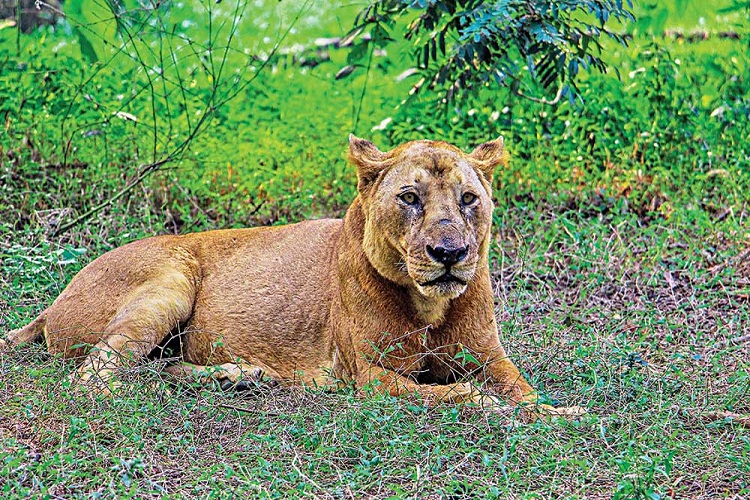Years ago when I was in school, I used to skip classes and roam about near Comilla zoo. The area was one of the most silent places of Comilla city. Almost penniless, I would wait for a local gang of young boys who had uncanny skill in hoodwinking zoo gatekeepers and entering the zoo premises without any ticket. I remember a healthy young lion prowling with pride in a small shabby cage, looking askance at visitors lest they should pelt or prick him, and sometimes basking in the sun with his tongue sticking out to adjust body heat.
I still wouldn’t know the name of the lion until two weeks ago when news published in the national dailies that an ailing lion called Juboraj was just in his twilight years, suffering from infirmity and other diseases without proper care and attention. I learned that his suffering came to an end with his death on 12 December, 2017.
Like Juboraj, Kanta is another ailing lioness, waiting for her painful days to end at Bangladesh National Zoo. As I stood by her cage, I saw two zookeepers trying to wake up the lioness from her slumber. In the back cage, separated from the front cage by a sliding gate, one zookeeper threw a small lump of meat — her daily allowance. The cage was dark and damp; no sunlight seemed to have ever reached it in a decade.

Another zookeeper slid the gate, hissed on end and made spluttering noise with tongue and lip to make the lioness stand from her peaceful, sedentary position. I was really appalled when one of them informed me that they repeat the same treatment everyday just because the lioness is blind. I began to search for an answer of their treatment to a blind lioness. Were they eagerly waiting for the lioness to die which would save some hours of ‘boring zookeeping’?
Kanta, the blind lioness, tried to stand on her weak forelegs and lurched back and forth, and sagged down several times. But her keepers couldn’t wait for long; they kept hissing and blowing raspberry. Two bespectacled gentlemen also joined their hissing spell which, to some extent, was enjoyed by the visitors. It was proclaimed in the mike repeatedly that hissing or jeering at animals is prohibited among other undoable things inside the zoo. Perhaps the visitors thought amusingly what they were not allowed to do was done by people endowed with ‘authority’; and they were ‘trained’ to break the law in their own ‘land’ because nobody understood jurisprudence better than they did.
 When Kanta could finally stand up, she stared at the visitors; her pupil turned white and scrawny physique revealing her bones. She fumbled for a way forward, not to take any food but perhaps as part of her morning ritual, which she has to painfully go through every morning. She almost hit the wall, but the keepers helped her this time with a distinct grunt, only to be decoded by Kanta. She entered slowly in the adjacent cage and waited for more signals; the keepers couldn’t provide any, so she kept walking to and fro and finally found her way to the back cage. She didn’t eat a morsel of meat; instead, she looked vacuously through a small window, showing her back at the visitors. Finding no more game in the cage, the visitors rolled back after a few minutes when Kanta flopped on the damp ground and lay almost motionless.
When Kanta could finally stand up, she stared at the visitors; her pupil turned white and scrawny physique revealing her bones. She fumbled for a way forward, not to take any food but perhaps as part of her morning ritual, which she has to painfully go through every morning. She almost hit the wall, but the keepers helped her this time with a distinct grunt, only to be decoded by Kanta. She entered slowly in the adjacent cage and waited for more signals; the keepers couldn’t provide any, so she kept walking to and fro and finally found her way to the back cage. She didn’t eat a morsel of meat; instead, she looked vacuously through a small window, showing her back at the visitors. Finding no more game in the cage, the visitors rolled back after a few minutes when Kanta flopped on the damp ground and lay almost motionless.
I and our photographer started for other parts of the zoo. We noticed that some cages were empty. The local visitors somehow got this impression that a zoo is a place of ailing animals, which inexplicably assigned a task to them: The animals needed to be discovered hiding in furrows and holes in their cage. It was a funny game! So, they craned their necks to find if there was any hidden animal inside the empty cage, an attitude fitting to the slack treatment at animals by zookeepers.
 But, there were none: some children cooed like dove and the walls inside the empty cage sent their echoing sound back. There was no Bhutanese cow, Wildebeest or Spotted Hyena in their enclosed area; only patches of grass grew unevenly here and there. The signboard with short description of animals gave no clue to the visitors what the animal looked like. Some animals were single. The enclosed area for horse also had some asses inside; the two species lived harmoniously and the visitors also seemed to have not taken it seriously.
But, there were none: some children cooed like dove and the walls inside the empty cage sent their echoing sound back. There was no Bhutanese cow, Wildebeest or Spotted Hyena in their enclosed area; only patches of grass grew unevenly here and there. The signboard with short description of animals gave no clue to the visitors what the animal looked like. Some animals were single. The enclosed area for horse also had some asses inside; the two species lived harmoniously and the visitors also seemed to have not taken it seriously.
Bangladesh National Zoo is currently home to 2,150 animals from 134 species. Undoubtedly, the number is quite large. But mismanagement is apparent everywhere in the zoo: in the treatment of the animals by zookeepers, in misleading signboards with empty cage and in the old, rusty cages of animals that have seen lack of renovation for years. The zoo does not have good reputation both for treating animals and increasing facilities for visitors.
 After a number of animal deaths in 2009, the zoo curator and deputy curator were temporarily suspended and a committee was formed to investigate the deaths. Zoo administration claimed that its main problem was the lack of veterinary doctors (it had only one doctor), and that it had already requested additional veterinary staff. The zoo was noted by international agencies as corrupt, and when two black rhinoceros were sent from South Africa to Dhaka in 2013, conservation groups in South Africa expressed concerns over appalling treatment of animals, calling it a “Hell hole”.
After a number of animal deaths in 2009, the zoo curator and deputy curator were temporarily suspended and a committee was formed to investigate the deaths. Zoo administration claimed that its main problem was the lack of veterinary doctors (it had only one doctor), and that it had already requested additional veterinary staff. The zoo was noted by international agencies as corrupt, and when two black rhinoceros were sent from South Africa to Dhaka in 2013, conservation groups in South Africa expressed concerns over appalling treatment of animals, calling it a “Hell hole”.
With heavy heart we left the zoo at noon. Perhaps Kanta had fallen in her long sleep in that shabby back cage, waiting for another long journey that would relieve her of pain, blindness and infirmity. Will the zookeepers be ever kind to her and make her last days more peaceful? Couldn’t she express her silent gratitude while breathing her last that she didn’t live her life in the wilderness, under the open sky, but she also didn’t live it less because somebody took care of her infirmity and blindness, somebody with a big, tender heart?

Photo: Alex Romario
Source : Daily Observer
RG











 When Kanta could finally stand up, she stared at the visitors; her pupil turned white and scrawny physique revealing her bones. She fumbled for a way forward, not to take any food but perhaps as part of her morning ritual, which she has to painfully go through every morning. She almost hit the wall, but the keepers helped her this time with a distinct grunt, only to be decoded by Kanta. She entered slowly in the adjacent cage and waited for more signals; the keepers couldn’t provide any, so she kept walking to and fro and finally found her way to the back cage. She didn’t eat a morsel of meat; instead, she looked vacuously through a small window, showing her back at the visitors. Finding no more game in the cage, the visitors rolled back after a few minutes when Kanta flopped on the damp ground and lay almost motionless.
When Kanta could finally stand up, she stared at the visitors; her pupil turned white and scrawny physique revealing her bones. She fumbled for a way forward, not to take any food but perhaps as part of her morning ritual, which she has to painfully go through every morning. She almost hit the wall, but the keepers helped her this time with a distinct grunt, only to be decoded by Kanta. She entered slowly in the adjacent cage and waited for more signals; the keepers couldn’t provide any, so she kept walking to and fro and finally found her way to the back cage. She didn’t eat a morsel of meat; instead, she looked vacuously through a small window, showing her back at the visitors. Finding no more game in the cage, the visitors rolled back after a few minutes when Kanta flopped on the damp ground and lay almost motionless. But, there were none: some children cooed like dove and the walls inside the empty cage sent their echoing sound back. There was no Bhutanese cow, Wildebeest or Spotted Hyena in their enclosed area; only patches of grass grew unevenly here and there. The signboard with short description of animals gave no clue to the visitors what the animal looked like. Some animals were single. The enclosed area for horse also had some asses inside; the two species lived harmoniously and the visitors also seemed to have not taken it seriously.
But, there were none: some children cooed like dove and the walls inside the empty cage sent their echoing sound back. There was no Bhutanese cow, Wildebeest or Spotted Hyena in their enclosed area; only patches of grass grew unevenly here and there. The signboard with short description of animals gave no clue to the visitors what the animal looked like. Some animals were single. The enclosed area for horse also had some asses inside; the two species lived harmoniously and the visitors also seemed to have not taken it seriously. After a number of animal deaths in 2009, the zoo curator and deputy curator were temporarily suspended and a committee was formed to investigate the deaths. Zoo administration claimed that its main problem was the lack of veterinary doctors (it had only one doctor), and that it had already requested additional veterinary staff. The zoo was noted by international agencies as corrupt, and when two black rhinoceros were sent from South Africa to Dhaka in 2013, conservation groups in South Africa expressed concerns over appalling treatment of animals, calling it a “Hell hole”.
After a number of animal deaths in 2009, the zoo curator and deputy curator were temporarily suspended and a committee was formed to investigate the deaths. Zoo administration claimed that its main problem was the lack of veterinary doctors (it had only one doctor), and that it had already requested additional veterinary staff. The zoo was noted by international agencies as corrupt, and when two black rhinoceros were sent from South Africa to Dhaka in 2013, conservation groups in South Africa expressed concerns over appalling treatment of animals, calling it a “Hell hole”.
